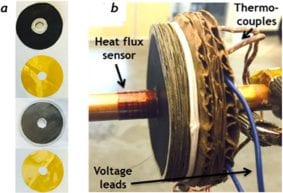Using organic materials in thermoelectric generators allows for a lightweight and inexpensive means to convert heat into electricity. Power is produced by converting temperature gradients into electric voltage, therefore suitable thermoelectric materials must have high electrical conductivity to carry the current and low thermal conductivity to maintain the gradient. In the past, expensive inorganic compounds were used to accomplish this task. However, recently conducting polymers have been produced for low grade waste heat recovery that have advantages over inorganic compounds.
Thermoelectric generators require both p-type and n-type materials. A number of high-performing p-type organic materials are available, but so far there are few options for n-type organic counterparts. In order to develop n-type organic thermoelectric materials, Shannon Yee and co-workers at the Georgia Institute of Technology have synthesized semiconducting polymer complexes with nickel centres. Their work was recently published in the Journal of Applied Polymer Science.
 Many n-type organic thermoelectric materials are not air stable – and those that are have low electrical conductivity. The researchers were able to tune the oxidation conditions and obtain electrical conductivity values that are 20 times higher than literature reports. Moreover, the nickel-polymer complexes have the advantage of being air stable, whilst maintaining high electrical conductivity.
Many n-type organic thermoelectric materials are not air stable – and those that are have low electrical conductivity. The researchers were able to tune the oxidation conditions and obtain electrical conductivity values that are 20 times higher than literature reports. Moreover, the nickel-polymer complexes have the advantage of being air stable, whilst maintaining high electrical conductivity.
The group went on to use the nickel-polymer complexes to fabricate a radial device with a new in-plane device architecture to tackle the problem of low power densities typically suffered by polymer-based thermoelectric generators. Using this unique architecture, power densities of milliwatts per square centimetre are achievable, and costs are significantly lower because of the facile fabrication process and the use of natural convection.
Documented in the Journal of Applied Polymer Science the p-type and n-type polymers are printed on paper and then cut into discs; silver ink is coated to achieve electrical contact. A copper rod is inserted through the centre of the stack to serve as the heat source. The outer edges of the polymer stack remain cool through natural convection, producing the necessary temperature gradient. The authors are now developing other metallo-organic polymers and small molecules thermoelectric materials with sufficiently high performance to reach their goal of achieving organic thermoelectric cooling. Ultimately this could enable wearable polymer thermoelectric cooling clothing.
Text written in conjunction with the authors of the original papers.

















